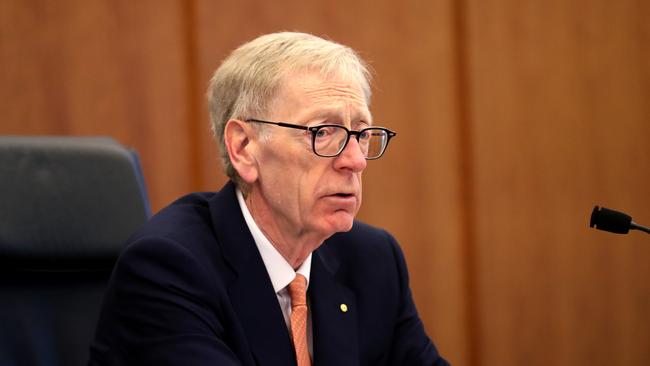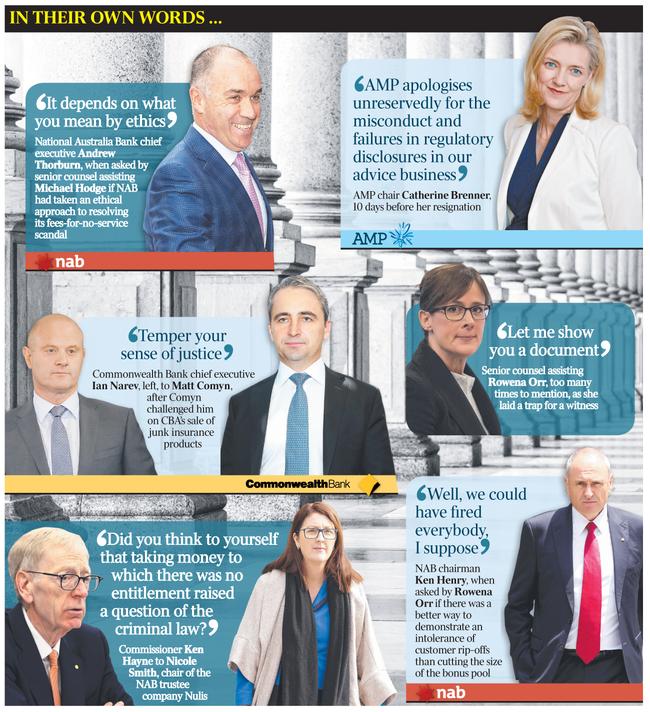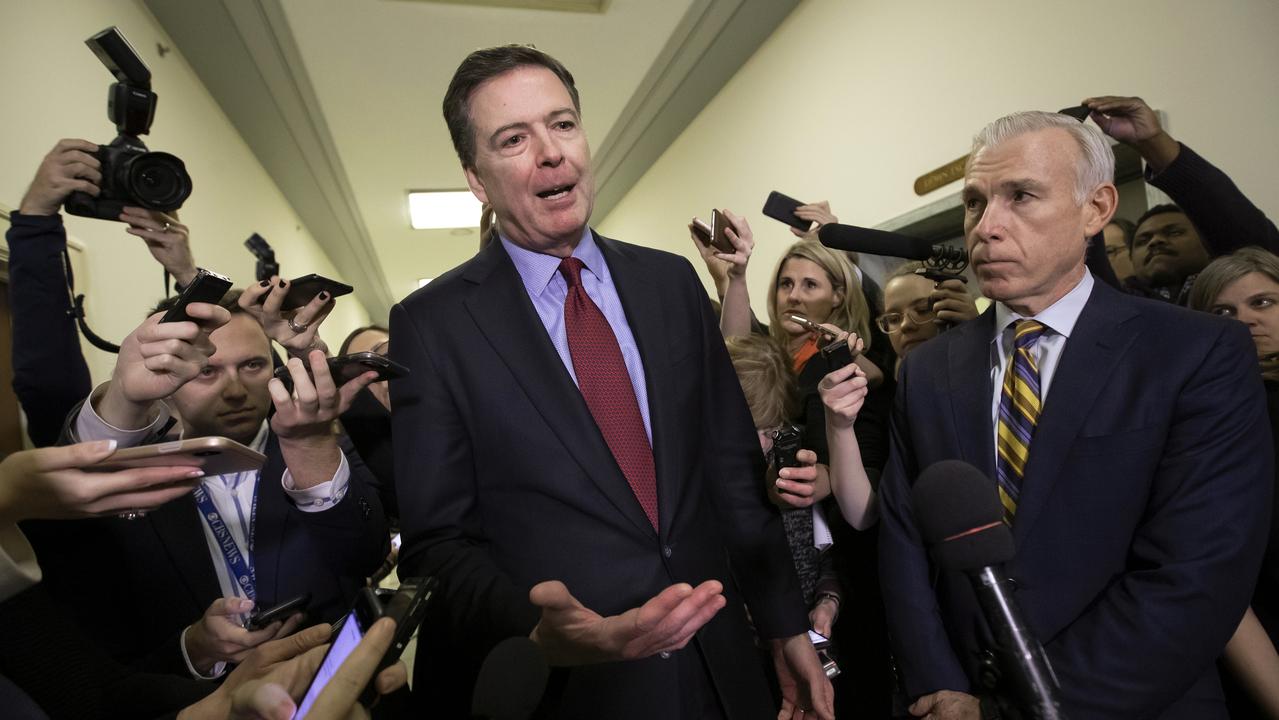Out of Ken Hayne’s frying pan, bankers scramble to prepare for reform
The sickness has been diagnosed. The cure is a matter of heated debate.

The nation’s bankers and regulators have learned from bitter experience since March that the ordeal of appearing before the financial services royal commission continues long after former High Court judge Kenneth Hayne uncages them from the witness box.
What comes next is a verdict handed down in the equally hostile court of public opinion.
“There’s only two outcomes — you’re either dead or you’re not dead,” one executive says.
For many witnesses, a session or two with commissioner Hayne’s crack team of lawyers, who were armed with thousands of documents the authors never expected would see daylight, has been the most terrifying experience of their professional lives.
AMP’s avuncular head of advice, Jack Regan, who went through a gruelling examination in the commission’s April hearings on financial advice, has not returned to work and it’s unlikely he ever will, at least not in a senior leadership role.
Regan accepted under cross-examination that AMP made 20 misleading statements or misrepresentations to the corporate regulator.
These and other revelations caused a board clean-out at the wealth-management giant, including the resignation of chairman Catherine Brenner and the accelerated departure of chief executive Craig Meller. The once-venerated company has shed more than $6 billion in value since its innards were exposed.
Ian Narev fared little better. While he never graced the witness box, a cloud hangs over the former Commonwealth Bank chief executive after his successor, Matt Comyn, said Narev told him to “temper your sense of justice” over the bank’s sale of junk insurance products.
The good news for the harried financial services sector, which is the nation’s largest contributor to GDP at $140 billion and employs 450,000 people, is that the public hearings are now over.
In its 68 days of examining witnesses, 7500 pages of transcript were generated. Hayne’s massive dragnet — often deployed late on a Friday when it would cause maximum disruption — hauled in 820,000 documents.
Infuriatingly for some, the commission heard from only 27 customers, but Hayne stressed from the beginning that he did not propose to run a forum for bank victims; case studies would be carefully chosen to identify where the system fell down and what should be done about it.

In the next eight weeks or so, the tempo changes as Hayne hunkers down to meet the February 1 deadline for his final report. Then, on February 2, he is largely forgotten as the bureaucratic machine cranks into gear.
A taskforce in the federal Treasury led by James Kelly, chief adviser in the department’s financial system division, has already been established to help develop the government’s response.
“It’s where the rubber hits the road,” a Canberra source says. “It’s going to be part of the (federal election) campaign, so the report isn’t going to sit on the shelf.”
Suffice it to say that the government’s response will have to be extremely carefully calibrated to avoid significant unintended consequences.
Heading the list of dangers is the prospect of the current credit squeeze escalating into a damaging crunch, or even a recession, if Hayne’s demonstrated interest in non-compliance with responsible lending obligations translates into a crackdown.
Already, the flow of credit into the housing market has slowed due to speed limits on investor lending imposed by the prudential regulator.
The banks, however, have anticipated a tougher responsible lending framework post-Hayne, asking for detailed information about customers’ living expenses instead of widespread reliance on statistical benchmarks like the household expenditure measure.
ANZ chief executive Shayne Elliott has said home-lending growth was likely to halve next year to 2.5 per cent, but investment bank UBS is much gloomier, predicting zero growth if responsible lending is strictly enforced.
Reserve Bank deputy governor Guy Debelle highlighted earlier this month that Elliott’s forecast was for “slower growth, not going backwards”.
“I think it’s tightening up but it’s in an environment where the economy’s going along fine — household income is growing and unemployment is falling,” Debelle told The Weekend Australian after a business lunch.
The Morrison government is well aware that fiddling with responsible lending carries very high stakes indeed. Treasurer Josh Frydenberg has noted that Hayne has brought into focus the twin issues of responsible lending and misconduct.
“While both issues are important, I do see them to some extent as separate with different responses required,” Frydenberg said.
“Great care needs to be taken around any further changes to responsible lending in order to prevent an unnecessarily restrictive approach to credit.”
Opinion is divided about Hayne’s likely recommendation.
One possibility is to lift the bar on responsible lending so that credit contracts have to be “suitable” for the customer instead of the current “not unsuitable” requirement. But as one commission participant said, that would amount to a lawyer (Hayne) instructing the banks how to lend.
“The commissioner won’t want his legacy to be the Hayne recession,” he said.
Beyond responsible lending, there’s an extensive list of issues for the commissioner to consider in his final report.
They range from the regulatory system’s shortcomings, conflicts of interest in the financial services industry, the link between variable remuneration and misconduct, the role and duties of mortgage brokers, a drive for simplification of the law instead of more regulation, and the right response to the endemic problem of institutions charging billions of dollars in fees but not bothering to provide the contracted service, such as financial advice.
Hayne was aghast at evidence that Commonwealth Bank, AMP and National Australia Bank had charged fees to dead people.
This extraordinary practice led Hayne’s searing executive summary in his interim report in September, in which he asked why all the misconduct had occurred.
“Too often the answer seems to be greed — the pursuit of short-term profit at the expense of basic standards of honesty,” Hayne said. “How else is charging continuing advice fees to the dead to be explained?”
The industry-wide fees-for-no-service debacle is widely tipped as a possible source of criminal charges. A civil case started in September against National Australia Bank.
Ominously, in August, Hayne asked Nicole Smith, chairwoman of NAB’s trustee company Nulis, if she’d ever wondered whether “taking money to which there was no entitlement raised a question of the criminal law”.
“I didn’t,” Smith responded.
Hayne has also taken AMP and NAB to task over dishonest or misleading dealings with the corporate regulator, the Australian Securities & Investments Commission.
This is not to say that Hayne has been at all happy with ASIC’s performance, or with that of the Australian Prudential Regulation Authority.
He scorched ASIC in his interim report for rarely seeking the deterrence value of public denunciation and punishment through the court system. APRA, he said, never went to court.
The regulators have stiffened their spines and have promised to do better.
ASIC supervisors are now embedded in the banks and Frydenberg came to the party earlier this month, shelling out $51.5 million in extra funding for commonwealth prosecutors and the Federal Court to process more civil and criminal matters.
Despite Hayne’s withering criticism of ASIC and APRA, Treasury appears to have taken off the table any prospect of a significant change in the regulatory architecture, saying in its submission on the interim report that a clear case for upheaval “has not yet been made”.
Treasury was like-minded with the commission on simplification of the law.
However, any serious attempt at reform would have to spread over the medium term to ensure attempts at a rewrite did not add to the problem.
Hayne’s view in the interim report was that pursuit of the dollar was the root of all evil in the financial system.
“All the conduct identified and criticised in this report was conduct that provided a financial benefit to the individuals and entities concerned,” he said.
“The governance and risk-management practices of the entities did not prevent the conduct occurring.
“The culture and conduct of the banks was driven by, and was reflected in, their remuneration practices and policies.”
Treasury and Hayne are in heated agreement over pay.
The commissioner displayed a virulent dislike of incentives linked to sales or short-term profitability, particularly for customer-facing staff, where the interests of the customer often come a distant second to the deal.
Macquarie Group chief executive Nicholas Moore, who confirmed that 80 per cent of his own profit share was deferred for up to seven years, breezed through his appearance at the commission.
It’s beyond doubt that pay frameworks in the financial services industry will be significantly reformed, including the adoption of deferred pay.
The Banking Executive Accountability Regime, which was introduced this year, has cracked down on sales and profit-driven cultures, requiring bankers by law to defer a proportion of their pay.
Treasury said consideration should be given to extending BEAR to other industries regulated by APRA, such as superannuation and insurance. A senior executive could have explicit accountability for ensuring that remuneration principles and policies set by the board were cascaded through the organisation.
The mortgage broking industry, which settles about 55 per cent of residential home loans, is also set for a revolution, along with other financial intermediaries.
Instead of charging a fee, brokers typically receive upfront and trail commissions, setting up a conflicted remuneration model that can result in significant financial harm to consumers.
Hayne said predictions of annihilation for the mortgage broking industry should be “examined with special care”.
According to Treasury, consideration could be given to the introduction of a duty on brokers to act in the interests of consumers.
The commission’s terms of reference obliged it to maintain an exclusive focus on the sprawling financial services industry. Despite this, the ripple effects will be far-reaching, partly because of the media exposure and the level of public interest.
Hayne has succeeded in democratising finance, or financial misconduct at the very least.
While it was ASIC that came up with the term fees-for-no-service, it was the commissioner who reframed financial concepts and brought them into the nation’s living rooms.
He did this many times, but most notably when he asked Nulis executive Smith in his characteristically rasping tone if she’d ever thought about a criminal aspect to the institution’s conduct. The exchange sent shockwaves through the corporate community.
“The royal commission was already a serious issue, but it became a really, really serious issue,” a close observer says. “Everyone now has a sense of what these (episodes of misconduct) look like once they’re in the public gaze.
“This is going to change the face of corporate Australia.”



To join the conversation, please log in. Don't have an account? Register
Join the conversation, you are commenting as Logout